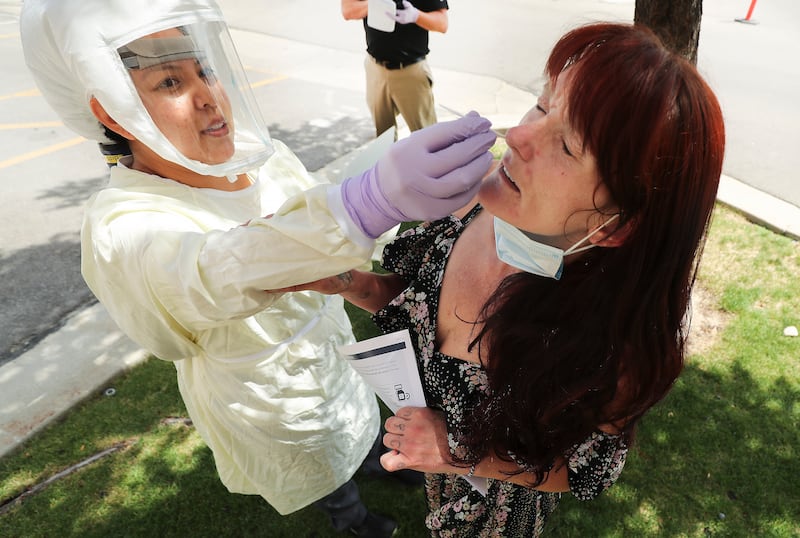SALT LAKE CITY — A few weeks into the new school year, Utah health officials on Friday reported the highest number of new daily COVID-19 cases since late July.
The state saw an increase of 656 cases on Friday out of 4,041 tests — a 16.2% positive rate, according to the Utah Department of Health.
“Today’s caseload growth is the largest daily net increase we have reported since late July. We are looking closely at the numbers, and want to reiterate, as we have throughout this response, that one day of data does not necessarily indicate a trend,” Dr. Angela Dunn, epidemiologist with the Utah Department of Health, said in a statement.
Of the cases reported Friday, 40% are from Salt Lake County and 33% are from Utah County, Dunn noted, and 40% of the cases are in the 15-24 age category.
School outbreaks — in which two or more cases were traced to a known school location, time and contact — have continued to rise, up from 38 on Tuesday to 45 on Friday, with 201 associated cases, according to state health department data.
“Additionally, many testing locations were closed Monday for Labor Day and Tuesday due to the windstorm. It’s possible people who would have been tested Monday and Tuesday waited until later in the week to be tested, resulting in an increase in the number of positive cases identified today,” Dunn said.

Counties’ risk status
Gov. Gary Herbert issued an executive order Friday allowing Box Elder and Carbon counties to move to the minimum level of restriction, a green or “new normal” status, under the state’s phased guidelines in the pandemic.
That means residents or visitors in those counties are still encouraged to wear face masks in business and social settings where social distancing isn’t possible, but other guidelines, including limits on social gatherings, are removed.
Now 13 rural counties are in the new normal phase, including Beaver, Daggett, Duchesne, Emery, Garfield, Kane, Millard, Piute, Sevier, Uintah and Wayne.
Counties still in the yellow or “low level” of restriction phase include Cache, Davis, Grand, Iron, Juab, Morgan, Rich, Salt Lake, San Juan, Sanpete, Summit, Tooele, Utah, Wasatch, Washington and Weber. Under the current phased guidelines, social interactions must be kept at 50 people or fewer for areas in the yellow restriction phase, and people are directed to wear face coverings in public when social distancing isn’t possible.
Many of those counties that have been allowed to move into the green phase are those seeing a low positive test rate.
The Centers for Medicare & Medicaid Services has begun providing county-by-county breakdowns of positive testing rates throughout the country. The data shows that 13 counties in Utah are seeing low positive test rates: Beaver, Carbon, Daggett, Duchesne, Garfield, Grand, Kane, Millard, Piute, Rich, San Juan, Uintah and Wayne.
Counties seeing moderate positive test rates include Box Elder, Davis, Emery, Juab, Morgan, Salt Lake, Sanpete, Sevier, Summit, Tooele, Wasatch and Washington.
Last week, Washington County commissioners — citing low case counts and hospital usage — sent a letter to Herbert requesting the area be moved to green status. The request had not been granted as of Friday.
Just four counties are listed as seeing high rates, with positive test rates 10% or higher, according to Centers for Medicare & Medicaid Services data. They are Utah, Weber, Cache and Iron counties.
New cases
Now 56,675 cases have been confirmed out of 707,807 people tested since the pandemic began in Utah.
The rolling seven-day average for new cases is 402 per day, and the average positive test rate is 9%. Currently, 123 patients are hospitalized with COVID-19, five more than on Thursday. Since the outbreak started, just under 3,300 people have needed hospitalization for the disease in Utah.
Another death was also reported Friday, a Salt Lake County man older than 85 who was not hospitalized when he died. He brings the state’s toll due to the disease to 431 deaths.
Just over 48,000 of the state’s cases are considered recovered after surviving the three-week point since their diagnoses, meaning about 8,200 infections remain active.
On Friday, the last group of New York City nurses visiting Utah as part of an exchange between Northwell Health and Intermountain Healthcare prepared to leave after spending two weeks sharing the knowledge they gained while fighting the country’s worst outbreak of the disease.
“I’m very grateful for the experience that I’ve had here. I’ve made a lot of friendships with the patients and the doctors, and the nurses and all the staff,” said Nancy Delassalle, a Northwell critical care nurse.
“We were really in the thick of things in New York,” she said, when Intermountain nurses earlier this year traveled to the city to help during its surge in cases.
While she said “everyone was great” to the nurses in the Beehive State, Delasalle urged Utahns to “be mindful of wearing your mask” and other precautions to prevent spreading the disease.



